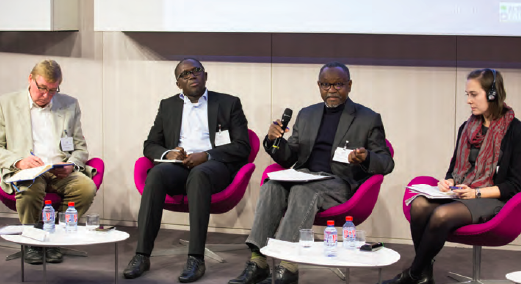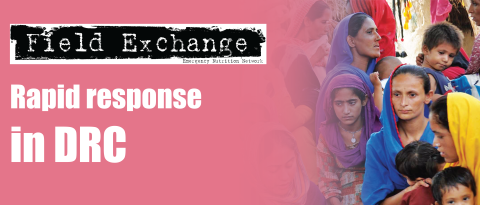How to ensure quality research uptake
By Stephanie Stern
 Stephanie Stern leads the Action Against Hunger LAB project which aims to reinforce the impact and uptake of knowledge. Before joining Action Against Hunger, she worked for the Strategy & Analysis Department of Save the Children International and was a research fellow at IRIS, the French think tank on international relations and strategic affairs. Her work focused on the transformation of the humanitarian system.
Stephanie Stern leads the Action Against Hunger LAB project which aims to reinforce the impact and uptake of knowledge. Before joining Action Against Hunger, she worked for the Strategy & Analysis Department of Save the Children International and was a research fellow at IRIS, the French think tank on international relations and strategic affairs. Her work focused on the transformation of the humanitarian system.
The ACF research conference, Paris, 2016, included a plenary session and panel discussion on how to ensure research uptake for nutrition research in emergencies. This article summarises this session, reflecting contributions from Patrick Kolsleren, Gent University (moderator); Abdoulaye Ka, Undernutrition Unit of the Senegalese Prime Minister’s office; Zvia Shwirtz, Uptake and Communication Manager for the REFANI project; and Mahaman Tidjani Alou, Abdou Moumouni University of Niamey, and plenary session panel discussion.
Defining research uptake
The discussion began with panellists sharing perspectives on what constitutes research uptake. Zvia Shwirtz asserted how important it is to define ‘research uptake’ and what it entails before any research uptake strategy (RUS) or activities are put in place. The definition agreed upon by all partners for the REFANI project was: “The process whereby research findings are communicated and utilised by a target audience.” The definition, and associated strategy and activities, was based on the premise that continuous stakeholder engagement and dissemination of evidence will ultimately lead to research uptake. Tidjani Alou suggested that sharing research findings that have social implications is a means to create appetite that can galvanise “social agitation”, as described by the sociologist and philosopher Jürgen Habermas (Calhoun, 1992) around subjects of interest.
Two fundamental questions are: “How do we ensure evidence is utilised by key stakeholders, both in policy and practice?” and: “When should research uptake activities begin?” The panel reflected that an efficient RUS is more than just a sum of activities; it is a continuous process that should take place throughout the entire research project cycle, with various challenges and opportunities. These were examined in more detail during panel exchanges and plenary discussion; a selection of these insights follows.
Uptake challenges
Academic and operational partners may have different interests when collaborating on research together. It is important to find a happy medium between producing robust evidence and publishing findings in journals, and sharing results with stakeholders as quickly as possible. Academics typically seek robust evidence and finalised results before making any statements on findings or engaging in dissemination; this may conflict with operational partners who want to apply the results as quickly as possible and rapidly influence policy and practice.
Researchers tend to move on once a research project is completed, yet this is when the critical dissemination and communication to key stakeholders needs to take place to ensure maximum impact. At the same time, continuing local stakeholder engagement and local dissemination can be difficult once a project has finished.
Keys to success and attention
Improving communication
Continuous engagement with stakeholders is critical. Project information should be shared as it becomes available, e.g. through conferences, meetings with various stakeholders and donors and by hosting specific events. Communication with stakeholders should not wait until results are published, but should start from the very beginning, when research questions are elaborated. But while traditional methods (publications, public and technical debates, conferences, etc) have a role, these routes are arguably limited; they do not create genuine open dialogue. This reflects a missing link between researchers and practitioners that enables coherent dialogue; practitioners and researchers may speak to each other, but not truly understand or hear what the other is saying. The two communities have different logics and ways of thinking. A third specialism may be needed, comprising individuals capable of understanding the research results and translating them into practical and understandable information. This concept has been described as “social mediation” (Nassirou Bako-Arifari et al, 2000); social mediators support the research during the entire process and once the results are issued, work with the public sector to see where they can make things change.
A critical question, given that knowledge produced can have political and social impact, is: “What is the researchers’ responsibility in mediation?” An example was shared from Niger where research on water points enabled resolution of decades-long conflict between two villages regarding land issues. The researchers were involved in mediation with local government. Such mediation by researchers has limitations as he/she may have limited familiarity with the context.
Researchers publish in a format that is not accessible or is too technical for most stakeholders. Eighty-two per cent of articles published in the humanities are not even cited once. Of those articles that are cited, only 20 per cent have actually been read. Half of academic papers are never read by anyone other than their authors, peer, reviewers, and journal editors (Lattier, 2016). The fora where research information is exchanged and discussed are not frequented by practitioner stakeholders and decision makers. Research information should be presented to stakeholders in a format that is short and gives a clear conclusion so that the information can be quickly translated into a decision. Important efforts are needed to improve communication between stakeholders and researchers and identify new ways to communicate coherently and succinctly.
Fulfilling users’ expectations
Practitioners and agencies need evidence. The UN Food and Agricultural Organization (FAO), for example, is a “knowledge organisation” that works to create linkages between research and politics and between research results and policy and programming. The FAO works with research institutes on subjects defined by FAO; the primary goal is not scientific publication but to have a guidance note with a strong operational focus to help programmers and policy makers. More broadly, it was observed that there is often a discrepancy between expectations of the researcher and the final user. Scale-up is also an important issue; final users need guidance on how and whether results are scalable or applicable to other contexts.
Upstreaming research in strategic planning
There are important lessons to learn from upstreaming research in strategic planning at country level. In Senegal in early 2000, for example, evaluations were used to investigate the effectiveness of the national nutrition programme, which proved extremely useful to prove the impact of the approach and strategy. When the government decided to adopt a multi-sector approach to fight undernutrition, research played a key role in defining what needed to be implemented, supporting strategic and operational guidance. The multi-factor and multi-sector character of combatting malnutrition makes the challenge of ensuring coherence between the needs of researchers and operational actors even more interesting. At country level, we are typically tasked with setting up multi-actor, multi-service platforms at household, community and government levels. Research challenges play out at all tiers.
In Senegal, research is well positioned in nutrition policy as a transversal element to support the definition and effective implementation of strategies aligned with the needs of the country. It fuels the choices of different strategies in the planning stage, supports implementation by providing guidance on how to ensure the effectiveness of interventions and is fundamental in providing information to the M&E system to explain successes and failures.
Research still faces multiple challenges, including: the lack of French language publication/translation of research that hinders uptake in Francophone countries; how to adapt to different national and local contexts; the need to have dialogue with decision-makers and operational staff (practitioners); and the critical mass of skills that must be created to generate evidenced actions.
Bridging the gap between researchers and practitioners
A more holistic approach to knowledge management is needed, involving more than sporadic annual discussions and more open, transparent and continuous dialogue. We need to broaden our horizons and set up shared knowledge platforms, breaking down the divides that currently exist between researchers, practitioners and decision makers. This is how the Senegalese government is approaching its nutrition policy, gathering all the concerned stakeholders round the table – including academics and scientists engaged in all the different sectors impacting nutrition – and monitoring and evaluating the impact of this holistic approach.
Action-driven research
There are three dimensions to research uptake. There is the needs aspect that is the problem at hand; the demand side expressed as a need for information to support decision making; and the offer, i.e. what researchers produce. In an ideal situation, these three dimensions overlap, but often in practice they do not. Researchers offer research results within the perspective of their academic freedom. When this is offer only, the research may be innovative but is still perceived by stakeholders as useless, because it does not help them make decisions. From the demand side, stakeholders have difficulties expressing their need for information in a format to which researchers can respond. Given that the research agenda is driven by external donors, the demand side cannot be met if the need does not fit donor priorities. Local funding for research is often lacking, so that local demand has little or no traction. Research to answer a particular question might not be innovative enough or too implementation-oriented, making chances of publication slim; academics may be less interested in pursuing such research from the outset.
Uptake of research results can be enhanced by identifying the questions stakeholders have from the beginning and responding with research to answer these questions specifically. Research uptake should be considered as a participatory process, engaging all the stakeholders at different levels and moments of the research cycle. Its efficiency lies in the combination of various elements: responding to a question which interests donors, stakeholders (including beneficiaries) and researchers and ensuring all the concerned actors are adequately informed and engaged in the research process, the dissemination of its results and their application to improved policies and practices.
To view a video of this panel debate, visit here.
References
Habermas and the Public Sphere, ed. Craig Calhoun. Cambridge, MIT Press, 1992, p.109-142.
Nassirou Bako-Arifari T, Bierschenk G, Blundo Y, Jaffré T, Alou-Apad. Karthala, 2000. Une anthropologie entre rigueur et engagement.
Daniel Lattier. Why Professors Are Writing Crap That Nobody Reads. October 26, 2016. www.intellectualtakeout.org/blog/why-professors-are-writing-crap-nobody-reads


